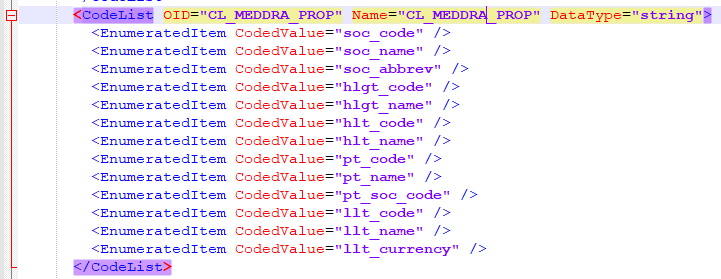Medical coding in ODM export
Introduction
This lesson describes how the medical coding information is structured within an Operational Data Model (ODM) file exported from Viedoc.
For general details about data export, see Exporting data.
Codelists
Dictionary type
There is one CL_DICT_TYPE codelist that contains one entry for each dictionary type present in the exported data:

Dictionary instance
There is one codelist for each dictionary instance present in the exported data, which contains one <ExternalCodeList> element pointing to a specific dictionary version, that specifies:
- Dictionary type -
Dictionary - Version description -
Version - Source hash -
ref

Dictionary properties
There is one codelist with dictionary properties for each dictionary present in the exported data. Each such codelist contains items for each property the dictionary defines:

Coding scopes
There is one codelist for each dictionary coding scope present in the exported data, specifying:
- Coding scope ID
- Coding scope name

Medical coding items
Association
For each medical coding item, there is one <Association> entry.
Each Association links an item (identified by the KeySet, see the description below) to a set of properties related to a specific Annotation (see detailed description below).
KeySet
The KeySet is generally used to identify the start and end of the annotated "link". In this case, both key sets are the same, as they identify the same entity, namely the one the respective action (defined under the Annotation) corresponds to.
The KeySet specifies the following attributes:
StudyOIDSubjectKeyStudyEventOIDStudyEventRepeatKey- Depending on the medical coding scope (Event/Activity/Form/Item group/Item), the following may be specified:
FormOID- not applicable for event scopeFormRepeatKey- not applicable for event scopeItemGroupOID- applicable for item group and item scopeItemOID- applicable only for item scope
Annotation
The Annotation consists of a set of <Flag> elements, and an audit record if the export was set to include the Viedoc extensions.
Flags

1. One flag element for the annotation type, with a <FlagValue> that is always MedicalCoding in this case.
2. One flag element for the dictionary type, with a <FlagValue> set to one of the CL_DICT_TYPE items.
3. One flag for the medical coding scope, with a <FlagValue> set to one of the CL_CODING_SCOPE items.
4. One flag element for the code sequence number, with a set to one of the CL_CODE_SEQ_NO items.
5. One flag element for each dictionary property set, with a <FlagValue> set to the dictionary property codelist (for example CL_MEDDRA_PROP) and a <FlagValue> set to the property value.
AuditRecord
The <v4:AuditRecord> is a Viedoc extension and is included in the output file only if the option to Include extensions was selected at export time.
It contains information on the user ID and the date/time stamp.
In the example image below the user ID = 304:

